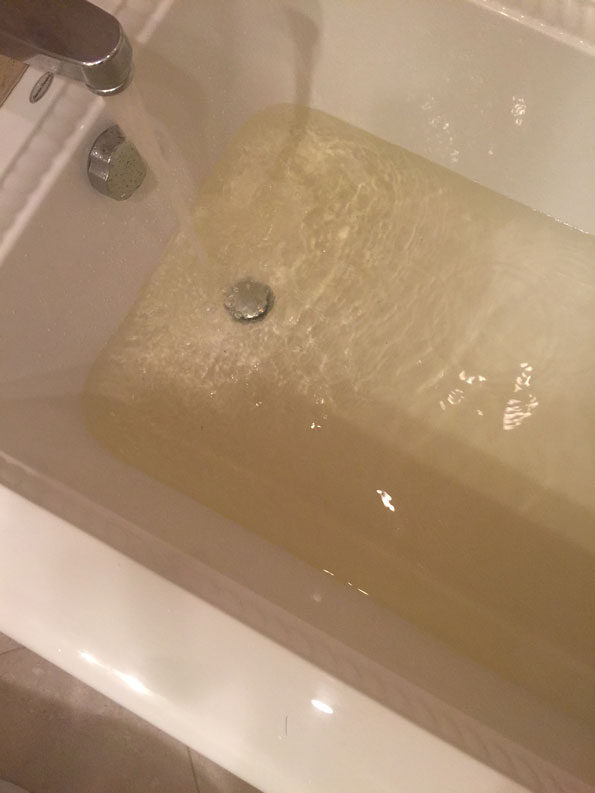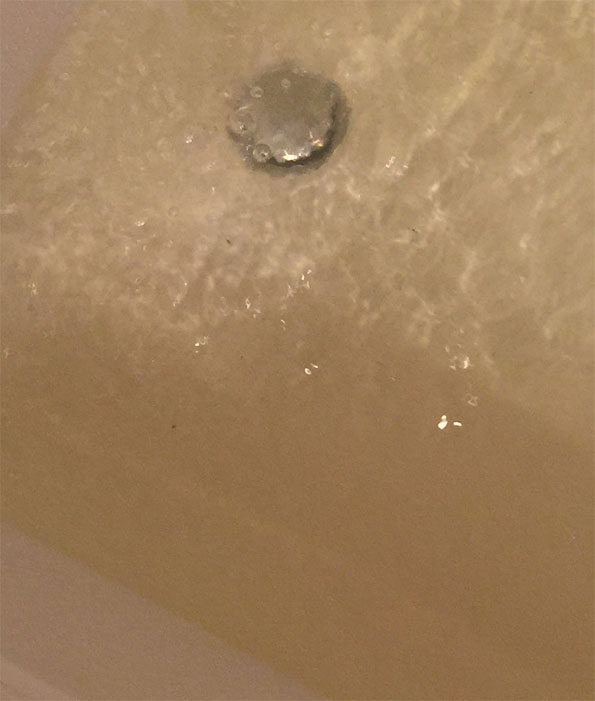VIDEO: Multiple Water Main Breaks Arlington Heights (Video includes a private contractor working at Brandenberry Park strip mall).
Arlington Heights Public Works Department crews worked an unusual amount of water main breaks beginning about Friday July 26, 2019. Twenty or more water main breaks occurred, which caused Arlington Heights to ask for help from crews from Rolling Meadows Public Works Department and Mount Prospect Public Works Department. Both neighboring communities sent crews from their public works departments to assist Arlington Heights.
Water main breaks have possibly been occurring at a slightly higher frequency this summer prior to the outbreak that occurred Friday through Sunday. One resident who lives in east Arlington Heights south of Kensington Road submitted a photo of discolored bathtub water, described as “water with sediment” from Tuesday July 23, 2019 at about 10:35 p.m. The resident was aware of a water main break nearby, but the break was not directly in front of their home. Another water main break occurred at Lynnwood Avenue and Pine Avenue on July 11, 2019 and there was another within a few hours apart, also in Arlington Heights.
Usually water main breaks are more common in prolonged cold weather. Initially there’s no absolute certain explanation for the cause of the outbreak of water main breaks this weekend, but it might be caused by maintenance work that is occurring this summer at the large water tower at Ridge Avenue and Thomas Street. The village has two large water towers — one on South Arlington Heights Road between Golf Road and Algonquin Road, and the one at Thomas Street and Ridge Avenue. It is possible that the equilibrium of water and air in the pipes across the village is out of balance while the Thomas Street water tower is taken out of the equation. Instead of being filled with water, the Thomas Street water tower is filled with air. Extra air in the system might hammer the pipes a little harder, or it’s harder to control the water flow while utilizing only one water tower at the far end of town. Also, the pipes in Arlington Heights are known to be aging. A perfect storm situation may have occurred because we also recently experienced a deeper frost line than normal with the record-breaking cold weather this past winter. A deeper frost line puts more pressure on the underground pipes below, which can cause breaks and brittle pipes.
When Should a Boil Order Be Issued?
Water pressure drops below 20 pounds per square inch (PSI) in any portion of the distribution system. A loss of pressure in the system can allow contaminants outside the water lines to enter the water system. Pressure loss can result from mechanical failure, power outage, main break, valve replacement, or high demand on an undersized water main.
In the event of pressure loss, a water system may take advantage of a “boil order exception” if there is historical data that indicates that an adequate and reliable chlorine residual was maintained in the system and the affected area, along with a written record of turbidity measurements in the affected area.. A certified laboratory either on-site or otherwise readily available is required to immediately analyze the required coliform samples. A condition of the “boil order exception” also requires that turbidity readings following any repair must not vary from the historical levels.
The bigger question might not be how the outbreak of water main breaks occurred, but how safe is the water when water breaks occur. Unfortunately, we can’t be too sure, so it is better be on the safe side. A water main break can cause what’s known as a negative pressure event. The pressure in the broken pipe falls low enough to permit material exterior to the pipe to enter the pipe and be distributed to homes. According to the EPA, any contaminant exterior to the water distribution system may enter potable water supplies during a negative pressure event.
Consider the possibilities:
1) A leaking sewer pipe near a water main break could allow fecal material to enter the so-called potable water distribution;
2) chemicals and fertilizers applied to lawns that have seeped underground could enter the so-called potable water distribution system; and
3) mud, clay and soil with bacteria could enter the so-called potable water distribution system.
Negative pressure events probably only put at risk a few residential or business properties or a small part of a neighborhood near a water main break. But people need to be properly notified, according to the EPA.
Chemical contaminants could include pesticides, petroleum products, fertilizers, solvents, detergents, pharmaceuticals, and other compounds. Predominant pesticides in urban areas include atrazine, simazine, prometon, and diazinon (Patterson and Focazio 2001). According to the EPA, other studies have detected insect repellants, fire retardants, and other industrial chemicals (Koplin et al. 2002). If chemical compounds intrude in sufficient concentration or volume, they might result in acute toxicity. Microbial contaminants are a concern because even with dilution, some microbes (e.g., viruses) could cause an infection with a single organism, according to the EPA.
The EPA advises that a boil order should be issued whenever water pressure drops below 20 pounds per square inch (PSI) in any portion of the distribution system because a loss of pressure in the system can allow contaminants outside the water lines to enter the water system.
Did you experience a water main break near your property? Did you get a boil order? Did you get a notice not to drink your water? Did you notice turbidity or discoloration of your water? Did you notice turbidity or discoloration of your water for a prolonged period?
Public works crews are highly skilled and knowledgeable in their work, which is demanding with long hours often under untimely circumstances.
Were notifications timely and informative?
Arlington Heights Water Main Break Outbreak Notification
“The Village experienced approximately 20 water main breaks this weekend due to an initial break that occurred near the water tower on S. Arlington Heights Road. Residents directly impacted by the breaks have received communication from the Village.
In some cases these breaks can cause temporary discoloration of tap water. Residents experiencing discolored water are asked to run water until it is clear (approximately 15 minutes). Unscrewing the aerator on your faucet and cleaning it out may also help.
If residents are experiencing issues or have questions, please call Public Works at 847-368-5800 from 7a.m. to 4 p.m., Monday – Friday.
Water main breaks at Oakton and Douglas and at Banbury Road and Mayfair Road in the Scarsdale neighborhood Arlington Heights
See also …
Abu-Ashour, J. et al, 1994. Transport of microorganisms through soil. Water, Air and Soil Pollution. 75:141-158.
Karim, M, M. Abbaszadegan, and M.W. LeChevallier. 2001. Potential for pathogen intrusion during pressure transients. JAWWA submitted.
Kolpin, D. W., E. T. Furlong, M. T. Meyer, E. M. Thurman, S. D. Zuagg, L. B. Barber, and H. T. Buxton. 2002. Pharmaceuticals, hormones, and other organic wastewater contaminants in US streams, 1999-2000: a national reconnaissance. Environ. Sci. Technol. 36: 1202-2111.
Patterson, G.G. and M. J. Focazio. 2001. Contaminants and drinking water sources in 2001: recent findings of the U.S. Geological Survey. Open File Report 00-510. USGS, Denver, CO.
Recommended Standards for Water Works, 1997. Great Lakes Upper Mississippi River Board of State Public Health & Environmental Managers. Health Education Services, Albany, New York.
Washington Post | For most of D.C., tap water is safe. But communication problems abound
^^ MOBILE? USE VOICE MIC ^^
facebook …
GET ALERTS on Facebook.com/ArlingtonCardinal
GET ALERTS on Facebook.com/CardinalEmergencies
GET ALERTS on Facebook.com/ArlingtonHeightsCrime
Please ‘LIKE’ the ‘Arlington Cardinal Page. See all of The Cardinal Facebook fan pages at Arlingtoncardinal.com/about/facebook …
Help fund The Cardinal Arlingtoncardinal.com/sponsor
20240105-1435future
THANKS FOR READING CARDINAL NEWS




 Amazon Best Sellers in Audible Books
Amazon Best Sellers in Audible Books